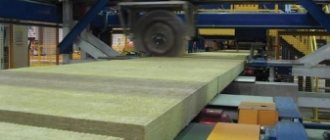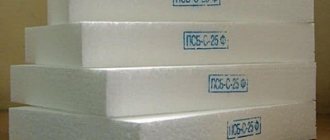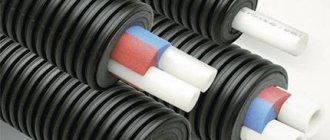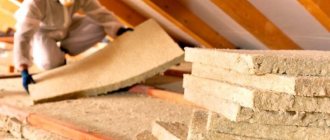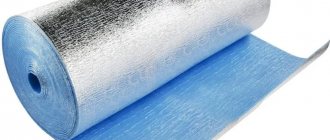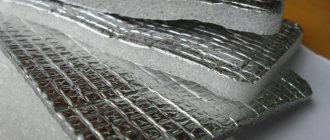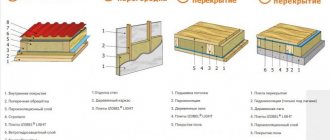Roll insulation is a material with a low thermal conductivity, which is additionally characterized by sufficiently low rigidity, but at the same time holds its shape well. Coatings of this type are flexible, which allows finishing areas of complex configurations. Laying such material is not difficult. However, it is important to choose the right dimensions. Insulation in rolls is attached end-to-end; it is unacceptable to leave significant gaps between adjacent sections of thermal insulation. This will lead to the formation of cold bridges.
Peculiarities
There are several types of insulation, mainly divided by composition.
Minvata
One of the most common thermal insulation materials on the Russian market is mineral wool. This is mainly due to a combination of price and technological properties of the material itself. It is very easy to use. It is advisable to choose a white, soft and self-adhesive material for the timber.
The name “mineral wool” is inherent in many thermal insulation materials that differ in their composition and properties. Not particularly popular is insulation, which is made by melting certain rocks to form certain fibers. During manufacturing, these fibers are woven into a single carpet; this wool is called “basalt”. Any resident of Russia and the CIS is familiar with the term “glass wool”.
This thermal insulation material is an outdated technology, but due to its price it is still in demand today. It is made by melting broken glass into single fibers. There is also cotton wool obtained by melting waste from the metallurgical industry (slag wool).
Due to the raw materials used in its manufacture, its price is much lower than that of glass wool or basalt wool.
Characteristics, pros and cons
Cotton wool differs from each other in technical characteristics. Glass wool has a high temperature threshold of 450 degrees, after which the material becomes irreversibly damaged. The density of glass wool is 130 kg/m3, and the thermal conductivity is about 0.04 W/m*C. This material is not flammable, it does not smolder, and has a high vibration and sound absorption threshold.
Over time, there is virtually no shrinkage, including options with long-term use.
The disadvantages include the fact that when water gets in, all the positive properties of this material disappear. Glass wool is a rather brittle and brittle material. Upon contact with skin, it causes irritation and itching, which is difficult to remove.
If it gets into the organs of vision, it can seriously harm them, as well as if it gets into the nasopharynx. You need to wear closed clothing when working with such material.
Basalt wool can withstand high temperatures (up to 710 degrees). Its thermal conductivity is about 0.04 W/m*C, density varies between 210 – 230 kg/m3. Unlike glass wool, this material is not afraid of moisture and does not lose its properties. When contacted with skin, roll insulation does not cause irritation or itching.
Slag wool has the greatest mass and density. Its density ranges from 390 to 410 kg/m3, and its thermal conductivity is about 0.047 W/m*C. However, its temperature maximum is much lower (about 300 degrees). The slag melts, and during the melting process its structure is destroyed, irreversibly.
The sizes of these materials vary, depending on the manufacturer's standards. However, the most common ones are:
- length from 3 to 6 m;
- standard width is 0.6 or 1.2 meters.
Some manufacturers make other width sizes (0.61 m). The thickness of the wool is standard (20, 50, 100 and 150 mm).
Foil material
Often one side of the insulation is covered with a layer of foil material. This allows you to protect the coating from moisture and ultraviolet rays. Most often, such materials are used for internal insulation of premises; the wool itself can be absolutely anything. The types of such material are varied. These include polystyrene foam, cork, and polyethylene.
The most popular material on the market is polystyrene foam. It is very practical and inexpensive. Copes perfectly with sound insulation and vibration. The length of the roll is usually 10 m, the width does not exceed 0.5 m. This material copes well with moisture and fungus. However, in terms of thermal insulation, it is significantly inferior to foamed polyethylene.
Thermal insulation with cork is characterized by high strength, light weight, harmlessness and good appearance. For wet rooms, it is recommended to use cork flooring with wax impregnation. The dimensions of this material are the same as those of expanded polystyrene. A fairly good material is foamed polyethylene. It consists of small cells filled with air, with cardboard or paper along the edges.
The substrate is secured by lamination. Due to this, it is possible to achieve the most durable and reliable connection with any type of base. Roll insulation has good thermal conductivity characteristics. Depending on the purpose, there are foil and metallized coatings.
For vapor reflection, a foil type of material is more suitable; for vapor containment, metallized spraying is required.
Spraying is very fragile and is damaged by small mechanical impacts. The foil material has excellent heat-reflecting characteristics. It is less susceptible to mechanical damage. Today, silver material with a reflector is quite popular.
Cork insulation for surfaces
An environmentally friendly and durable raw material for the production of thermal insulation is cork oak bark. Absolutely natural ingredients make the rolls safe for health. The crushed bark is combined with organic glue and pressed. Thickness ranges from 2 to 6 millimeters. The length of the roll reaches 10 meters, the width is mostly one meter. Most often, in this form, the cork goes under wallpaper, on a substrate for laminate or “warm flooring”.
The thermal conductivity indicator is not inferior to mineral wool, but the layer used is much thinner. Cork insulation is not flammable, does not absorb water well and retains noise. However, its density is high, and therefore its weight is high. The safety factor is high, the service life is stated to be up to 50 years. The negative side is the price of “naturalness”; compared to the others, it is quite high.
This insulation is produced mainly by Portuguese companies: Wicanders, Izora, Amorim. They offer a wide range of insulating rolls, which can also serve as wall decoration. Installation is also simple; basically, the cork is “set” on glue.
Modern technologies provide a huge selection of heat insulators for any premises and structures. The selection criteria are based on what surface needs to be covered and how much the buyer is willing to pay for it to maintain comfort in their home.
Scope of application of roll insulation
This type of material is universal, due to its properties (low rigidity and density, flexibility). This means that it can be used at facilities for various purposes (private, commercial, public, etc.). However, it should be remembered that each type of such material may have restrictions on its use, for example, if it does not meet operating conditions. Roll insulation is suitable for installation on horizontal and vertical surfaces. It is dense enough to maintain its shape.
A coating with a metallized layer is installed on objects and surfaces where it is important to provide the highest level of protection against heat loss: in baths, saunas, when installing water/electric heated floors, etc. The desired effect is achieved due to the presence of a heat-reflecting layer.
Roll insulation is the only affordable materials that are suitable for protecting surfaces with complex configurations: with differences in levels (stepped), bends, joints, and hard-to-reach places. This opportunity is due to flexibility and low rigidity.
Directions for using this type of thermal insulation:
- covering walls outside and inside for decorative finishing of any kind (hard boards, soft materials and even wallpaper);
- floor protection, in this case the roll insulation is protected from deformation by the lathing;
- insulation of flat/pitched roofs;
- reduction of heat loss through the ceiling;
- protection of pipes for various purposes.
conclusions
Rolled thermal insulation is in many cases preferable because it is characterized by flexibility. In addition, the material of this group has low thermal conductivity, which allows it to be used to insulate an object. However, it should be borne in mind that fiber roll coatings do not tolerate contact with liquids well, so they must be carefully protected with waterproofing.
If you plan to use foam insulation, it is important to remember that they do not allow steam to pass through, which means the microclimate in the room may worsen. To avoid negative consequences when installing this type of insulation, it is recommended to install supply and exhaust ventilation or increase the efficiency of natural air circulation in the room.
So which option is better to choose: cotton wool or polyethylene foam?
The main point that is important to understand is that foamed polyethylene or polypropylene in the form of rolls is precisely thermal insulation, that is, a material whose purpose is to slightly improve the characteristics of walls, and not to fully insulate them. Regardless of where it will be fixed - from the inside or from the front.
But basalt wool is already a real insulating layer. True, if used indoors, the wall will still freeze, but noticeably less heat will escape from the room.
It turns out that foam propylene from the inside will give less effect than cotton wool, since the temperature will only rise by a degree and a half. And even if you carry out external installation, the “picture” will be the same, but with only one positive aspect - the wall will freeze a little less and condensation from the room will disappear.
At the same time, the material has an undeniable advantage - it is cheap and very easy to install. It is more difficult and expensive to work with cotton wool because you will need to make a false wall (usually drywall) to protect the basalt fibers, and in addition, it is important to take care that moisture does not get into the structure of the material. If this happens, then the effect of all the work done will be zero, since all the thermal insulation qualities will very quickly disappear.
Here it seems that cotton wool is better anyway (because it’s “warmer”), but everything is decided by the nuances of the situation. Yes, cotton wool seems to be good, but what is the point in it if, for example, you need to insulate a shower room not in the house, but, for example, in the country and you don’t want to invest? The obvious budget solution in this case is a metalized insulator - stick it on the wall and forget it.
But in the case of a more or less capital approach, but again in the absence of significant financial resources, it is better to opt for mineral wool and insulation from the inside. It turns out that there is no ideal option and you need to make a decision only based on the characteristics of the project.
Roll insulation
is the name of a whole class of lightweight thermal insulation, widely used in civil and industrial construction. They are made from staple fiberglass with the addition of various binding materials, fillers, water repellents (substances that repel water), which give them softness, elasticity and resilience. Rolled thermal insulation is the most inexpensive of all types of insulation, and therefore is in consistently high demand among builders.
Conditions for the use of internal thermal insulation
The outer walls of an apartment building are now finished using building materials that retain heat. In private houses, thermal insulation along the facade is also not uncommon. If this method is not enough for you, you can insulate the walls from the inside.
The case for technology
By simply installing insulation, you will retain up to 30% of the heat in your rooms that escapes to the street. Other advantages of the technique include:
- ease of laying materials from the inside with your own hands - no need to make scaffolding or use special equipment;
- work is carried out year-round, in any climate;
- independent cost planning - if there is no money for a full-scale renovation, you can make thermal protection room by room;
- wide selection of thermal insulators.
List of main disadvantages
Some craftsmen consider insulating walls inside a house problematic for the following reasons:
- cracking of the external supporting structure during its interaction with the environment;
- protection from the cold of the building on only one side;
- condensation formation as a result of a shift in the dew point between materials and the surface;
- reducing the usable area of the room by 10 cm on each side;
- risks of the appearance of “cold bridges” when arranging the frame and reducing the efficiency of work.
On a note! Before starting the event, you should choose the size of the insulator using an online calculator.
Types of materials in rolls
There are two groups of insulation materials, characterized by flexibility, low density and rigidity:
- Based on expanded polystyrene, polyethylene. Such materials are characterized by a closed-porous structure, which is achieved by foaming the raw materials. As a result, most of the volume is a gaseous medium. By foaming polyethylene, a flexible coating of small thickness is obtained. Roll insulation of this type is characterized by low thermal conductivity, wear resistance, and lasts a long time.
- Mineral wool is presented in varieties: glass and slag wool, basalt or stone wool. These are natural insulating coatings characterized by low thermal conductivity. Disadvantages include low strength, tendency to sag during operation, and hygroscopicity. The last of the properties is the reason for the short service life of the coating. This insulation is suitable for walls, floors, ceilings, attics, basements, and roofs. If you provide protection from moisture in areas with high loads, you can avoid deformation of the coating.
Foam insulation is divided into types, taking into account differences in the production method:
- physically stitched;
- chemically cross-linked;
- gas-foamed.
The first 2 options are characterized by similar properties, but are manufactured using different technologies. In addition, insulation materials are divided into types, taking into account differences in structure: foam with additives (fire retardants), foil. The last option has improved properties. It not only reduces heat loss, but also reflects thermal radiation, returning it back to the room.
Glass wool
The material is based on glass industry waste and sand. Raw materials are exposed to high temperatures (+1450°C). During the melting process, the finest fibers appear. To obtain a thermal insulation material, a binder is added to glue the fiberglass together. Then molding occurs. In order for the binder component to obtain the desired properties, it must undergo a polymerization process. At the last stage, the material acquires a yellowish tint as a result of dyeing
This type of thermal insulation layer protects different types of objects. Glass wool is a universal coating option. However, when working with it, you need to use personal protective equipment (respirator, goggles, gloves, closed clothing) . This is due to the fact that the insulation contains particles that are characterized by small mass and can be released into the environment under the influence of external factors. Dust enters the respiratory tract, settles on the skin and mucous membranes, which provokes tissue irritation.
To slightly improve the strength indicators, the rolled material is reinforced. The disadvantages, in addition to the release of abrasive particles, include relatively low thermal conductivity. In terms of this parameter, the insulation is inferior to its foam counterparts. Another disadvantage is hygroscopicity. The vast majority of mineral coatings strongly absorb moisture.
Advantages of glass wool:
- good sound insulation properties;
- sufficient level of strength;
- the material is lightweight, which means it will not weigh down the structure;
- installation does not require special skills;
- flexibility;
- vapor permeability;
- fire safety;
- elasticity, due to which the insulation can restore its original shape;
- small width means glass wool will not hide the space;
- resistance to mold and fungi;
- insulation is unattractive to rodents.
When choosing, not only positive/negative qualities are taken into account, but also coating parameters. Glass wool is characterized by the following properties:
- the thermal conductivity value is in the range of 0.039-0.047 W/(m*K);
- water absorption coefficient of glass wool for partial immersion – 15%;
- This type of insulation is used at temperatures of -60…+250°C;
- upon contact with water during the first day, the coating will absorb water in the amount of 1.7% of the total volume of thermal insulation material;
- sound absorption rate: from 35 to 40 dB.
In terms of thermal conductivity, glass wool is similar to the following insulation materials: mineral wool, expanded polystyrene.
Izolon
This is foamed polyethylene foam, which is characterized by a closed-porous structure. Available in the following varieties: simple, with a foil layer on one or both sides. Izolon is a fairly dense, but at the same time soft insulation. Its characteristics:
- the average thermal conductivity is 31 W/(m*K);
- density – 33 g/m³, with a decrease in the value of this parameter, thermal conductivity increases;
- the water absorption coefficient is 1%, which indicates that the insulation has no tendency to absorb moisture;
- the material does not allow steam to pass through;
- the ability to perform its main task (reducing the intensity of heat outflow) at low temperatures - down to -60°C, while the insulation does not lose its properties, does not break, does not deform;
- service life is about 100 years;
- resistance to negative factors is noted: precipitation, high loads;
- no toxic substances are released during combustion;
- the material is environmentally friendly;
- Izolon insulation protects the object from noise, and a decrease in the intensity of sound waves is noted even with a minimum thickness of the material.
If we consider the foil coating, we should highlight its ability to reflect heat. The insulation reflects 97% of the heat back into the room. Isolon is not deformable. This means that under the influence of moderate loads it retains its properties.
Plates in rolls
In this case we are talking about materials with increased rigidity, which are formed into rolls. These include basalt wool. This material is characterized by a fibrous structure and is superior to glass wool in terms of hygroscopicity and thermal conductivity. In addition, basalt wool in rolls is almost no different in density from isolon (30 kg/m³). Thermal conductivity of the material is 0.039 W/(m*K). In terms of water absorption coefficient, the insulation is inferior to foam analogues (15%). The main advantage of this coating is its non-flammability.
What materials cannot be used
Relatively recently, a popular method of thermal insulation was covering walls with foam plastic (expanded polystyrene).
Due to its low cost, the material is often used to this day for facades, ceilings and other surfaces. However, it has huge disadvantages and is not suitable for wallpaper upholstery:
- Wallpaper glued to polystyrene foam is easily subjected to mechanical stress and comes off. This occurs due to the fact that the material does not have the required rigidity;
- To achieve the desired level of insulation, you will need a layer of foam plastic at least five centimeters thick. Such a design will not stand out aesthetically;
- during the subsequent renovation of the room, you will have to remove not only the wallpaper, but also the insulation itself. It will not be possible to remove the finishing material without damage;
- One of the important reasons why foam cannot be used is flammability. According to the rules, during installation it must be insulated with another non-flammable layer.
Roll Size Chart
For comparison, we take insulation whose thickness does not exceed 50 mm. This is due to the fact that more massive rolled thermal insulation materials roll up much worse. The review involves fiber coatings. Manufacturers of insulation in rolls:
| Material grade | Width, mm | Length, mm | |
| Ursa M-11 | 1200 | The manufacturer offers two options: 7000 and 9000 | |
| Heat Knauf Dacha | 1220 | 7380 | |
| Isover Classic | 1220 | 8200 | |
| Isover Sauna | 1220 | 12500 |
To compare coatings by cost and determine the most suitable option, take into account the number of strips in the package.
Types of mineral wool in rolls
There are several varieties of insulation in this group. Their structure is the same, they differ in composition.
- Basalt wool. This material is made by melting rocks into the finest fibers that are intertwined randomly. By adjusting the density of the material, manufacturers obtain hard or elastic wool. The latter is applicable for rolls. The thermal conductivity of the material is the lowest of all similar options. This allows it to be a fairly common type of insulation. The weight of one cubic meter of cotton wool ranges from 30 to 100 kg. The maximum temperature it can withstand is 700 degrees. Manufacturers claim that the basalt components of cotton wool are safe for health. However, over time, particles of fibers and binders are found in the air.
- Glass wool. The same fibers are melted, but using glass waste . It has the lowest cost and density up to 25 kg/m³. It can withstand high temperatures, its maximum is about 450 C°. The above indicators destroy glass wool thoroughly. She copes with her main task well. A negative feature is the impact on the respiratory tract and skin during installation and operation. Therefore, thermal insulation made of glass fibers is mainly relegated to the role of only the outer layer.
- Slag-like. The third type of insulation is made from metallurgical waste (blast furnace slag). The price of rolls is also reasonable. However, this type of cotton wool is outdated; it was popular back in the USSR. Due to the fragility and allergenicity of the fibers, it is not used in residential areas. The density of the material is different: wool with an indicator of 75 kg/m³ is used for floors, 125 kg/m³ is suitable for walls. It is highly hygroscopic and loses its properties when wet. Not flammable, melts at temperatures above 300 C°.
Any type of wool must be covered with a vapor barrier, especially in rooms with high humidity. And it also holds back the smallest particles of fibers that appear over time and negatively affect a person. Raw materials often contain formaldehyde, which also affects health. High-quality rolls should have a minimum of this substance
Before laying mineral wool, a frame must be installed. On the walls, the panels that hold it in place are pressed firmly so that the canvas does not move out over time. For the necessary protection from the cold, the number of layers can be increased.
Manufacturers often divide their products according to the purpose of the insulation. For ceilings and floors, the rolls will be lighter. For the main floor, walls, and other surfaces, the density of the material is usually increased. Due to this, the dimensions of the roll also change:
- length from 3 to 8 meters;
- thickness in 3 options (50 mm, 100 mm, 150 mm);
- width from 0.6 m to 1.22 m.
Foamed polyethylene for insulation
Has many positive qualities. It is obtained by filling heated polyethylene with gases. As a result, a mass is formed with many closed bubbles inside, which subsequently hardens. For special strength, it is also “cross-linked,” i.e., the bonds of molecules are strengthened chemically.
two options on sale . Both types have very low thermal conductivity, but the first one still has better characteristics, and therefore costs more (its density is 30 kg/m³). The general properties of the materials are:
- they are durable;
- absolutely do not absorb water;
- easy to install;
- do not harm the environment and humans;
- they are not afraid of organic destroyers such as bacteria and fungi;
- The layer thickness required to retain heat is much smaller than, for example, mineral wool.
The difference is that cross-linked polyethylene foam is capable of absorbing sounds well, but its brother cannot boast of this. It works worse as a sound insulator. Under mechanical stress, the uncrosslinked version loses its shape irrevocably. Cross-linked has greater compressive strength, which means it can be used for insulating horizontal surfaces.
Due to the thinness of the material, rolls can be up to 30 meters in length, width from 0.6 to 1.2 m. Thickness reaches 1 cm. Negative nuances for polyethylene are flammability and current conductivity (electricity passing nearby must be well insulated) . To secure the material to the wall, special glue is required.
Manufacturers of insulating wool
Construction stores offer a wide selection of mineral wool. Let's look at the features of materials from some companies specializing in this area:
- Isover. This manufacturer produces mainly glass wool, which has decent characteristics. The materials are breathable and recover their shape well after mechanical stress. They do not emit harmful substances when heated. However, when installing any type of mineral wool, it is necessary to use personal protective equipment . Options for roofs have high protection against moisture and good sound insulation. Cotton wool of the “Sauna” brand (for baths and other wet rooms) has an aluminum coating, reinforced with reinforced mesh, which makes it possible not to use a vapor barrier.
- Ursa. Both universal and specialized glass wool is produced under this brand. For example, for hot pipelines or equipment heating up to 270 degrees. The manufacturer also offers a product with Pure one technology. It allows you to bend around irregularities due to the “spring” effect. The binder for the raw material is safe acrylic, which prevents the fibers from breaking. It is a good option for rooms with children.
- Rockwool. Produces durable basalt wool for technical use, which can withstand temperatures of 1000 C°. It is environmentally friendly and does not lose its thickness over time, as the manufacturer claims.
Knauf
The German company produces excellent mineral insulation materials. They are free from formaldehyde and other harmful substances, and thanks to the specially designed fiber structure, they do not provoke allergic reactions. However, the manufacturer recommends carrying out installation work with thick gloves. They perfectly muffle noise and are impregnated from insects, rodents and mold.
Mineral wool Knauf 1220Х6148Х50
- Dimensions 1220Х6148Х50 MM (15 m2).
- Thermal conductivity: 0.037 W/(m°K).
- Density 12 kg/m3.
- Cost 1100-1200 rubles.
Izover
The French company launched production at local sites. Offers a wide range of rolls with thicknesses from 20 to 150 mm, allowing you to retain heat in all weather conditions. There are many foil models that can be used in rooms and buildings with high humidity.
Penofol brand polyethylene foam
Penofol insulation appeared recently, but has already stood out among its peers. It is not destroyed by weather conditions and aggressive environments. Thermal insulators of this company have several varieties:
- the foil covering can be fixed on one or both sides;
- rolls with an adhesive layer (even more simplifies installation);
- specialized type of insulation for communication networks;
- insulation for harsh conditions with a thickness of up to 40 mm.
The combined technology makes it possible to further reduce the thermal conductivity of insulated surfaces. A moisture-resistant and durable material that does not require the cost of vapor barrier, can be used in various directions. Does not lose its properties in the temperature range from -60 to +100 C°.
Properties of roll insulation
All roll insulation materials have approximately the same properties, which determine their widespread use, namely:
- low thermal conductivity;
- good sound insulation;
- optimal hygroscopicity;
- high water-repellent properties;
- ease of transportation and operation;
- resistance to aggressive media (acids, alkalis, solvents);
- fire safety;
- optimal price.
If they are used to insulate a pitched roof that has a frame supporting system made of wood or metal, the insulation is placed inside the frame. When working with rolled thermal insulation on vertical and inclined surfaces, it is necessary to use a lathing or frame. The insulation is installed with compression to cover the “cold bridges”.
How to properly glue insulation to walls
Installation of insulation under the wallpaper is ensured by gluing it to the wall surface. The process technology is similar for all types of material. The difference lies in the choice of adhesive composition. Pasting is done in the following order:
Preparing the wall surface . The previous finishing coating is removed: paint, wallpaper, and old plaster. The wall is cleaned of dirt and dust.- Antiseptic treatment . The surface is carefully inspected for the presence of mold and fungal infection. Such areas must be treated with an antiseptic. Typically a solution of copper sulfate is used.
- Leveling the surface . Cracks and potholes are sealed. All irregularities are carefully removed. If necessary, leveling is carried out by plastering.
- Primer . It is necessary to ensure reliable adhesion of the insulation to the wall. The procedure is ensured by a deep penetration primer. It is best to use a ready-made composition. It is applied to the entire surface of the wall using a paint roller. In hard-to-reach places, use a paint brush.
- Uncover . Using a tape measure, the dimensions of the wall are measured, taking into account door and window openings, as well as other structural elements, such as niches or protrusions. If necessary, optimal use of each roll is ensured. It is cut into strips of the desired size with a sharp knife.
- Preparation of the adhesive composition . Produced in strict accordance with the manufacturer's instructions.
- Applying glue to the surface of the walls . After the primer has completely dried, glue is applied using a roller and brush. Its consumption is indicated in the instructions; these recommendations should be followed.
- Application of insulation . It is glued in strips and smoothed from top to bottom to remove air. The strips are laid end to end, without a gap. It is recommended to seal the seam with adhesive and seal it with masking tape. Excess material is cut off with scissors.
All subsequent operations are carried out only after the glue has completely hardened. This time is indicated by the manufacturer, usually it is at least 70 hours.
Installation should be carried out at an air temperature of at least 10 degrees, with a humidity of no more than 65%.
Do you use roll insulation under wallpaper?
Yes
No
Selection of adhesive composition
Different types of insulation require different adhesives. Expanded polystyrene insulation and polyfoam can be fixed to the wall using adhesives designed for heavy wallpaper. The most durable adhesives are those based on carboxymethylcellulose (CMC) and methylcellulose with the addition of PVA. Among domestic brands, KMC Super Extra and Moment Classic stand out. Foreign wallpaper adhesives are widely represented on the Russian market. Special mention goes to Kleo, Semin (France), Pufas and Metylan (Germany).
Cork insulation cannot be glued with regular wallpaper glue. Special adhesives are used for it. Adhesives received positive reviews: Pufas K12, Lacrysil, MultiFix, Wakol.
Advantages and disadvantages
The main advantages of rolled material are:
- Versatility. Suitable for thermal insulation of any surfaces. For complex spatial shapes, including curved ones, you can cut out a suitable piece.
- Minimum requirements for surface preparation before installation.
- Benefits in terms of material price and work productivity when insulating large areas of walls, especially straight sections.
Roll materials have disadvantages.
- High labor intensity when laying in frequent lathing; additional time is required for cutting.
- Low rigidity does not allow them to be used where it is necessary to withstand significant loads.
In general, the advantages compensate for the disadvantages, which explains the high popularity of roll materials among consumers.
The materials are harmless to health provided they are used correctly and fire safety regulations are observed.
Waterproofing methods
The building materials market and the continued interest of developers and manufacturers in this direction provide consumers with a wide range of moisture-proof coatings:
- polymer, polyethylene and anti-condensation films;
- membrane systems;
Membrane waterproofing
- waterproofing mastics;
- materials of penetrating and semi-penetrating action;
- insulating resins, cement mixtures and emulsions;
- sprayed polyurea and acrylate compounds;
- liquid applied isolates (liquid rubber);
- rolled materials;
- injection waterproofing agents.
Bipol TechnoNIKOL weld-on roll waterproofing
Constant innovation and development lead to increased demand for progressive coatings with increased service life.
What to consider when working
Insulation with mineral roll materials can be carried out at any time of the year, it is only important to ensure that the material is protected from precipitation.
The use of foam materials mounted on an adhesive layer depends on the air temperature. Usually the limit is down to –10C. Special adhesives are also produced that are effective down to –20C.
Before insulation begins, minimal surface preparation is required:
- Dismantle pipes, electrical wiring, lamps, decorations, plants, etc.
- Clean the walls from remnants of old coatings, debris and dust.
- Install lathing for mineral insulation.
- Level and clean the surface for gluing foam thermal insulators.
Installation does not require special equipment; the tools you will need are:
- construction knife;
- stapler;
- screwdriver;
- hammer;
- double sided tape.
It is more convenient to carry out installation and cutting of roll insulation together by two people, especially for large volumes of work. Small volumes can be done by one master.
Insulation process
The sequence of operations when installing mineral insulation is as follows:
- A vapor barrier film is attached to the prepared wall.
- The sheathing is made of wooden bars or metal profiles. The recommended guide pitch is 50 or 60 cm.
- Rolls are cut in accordance with the selected pitch. The cutting must be carried out so that the insulation fits tightly between the guides and, when straightened, provides a better fit to the guide.
Disc-shaped dowel The not always convenient and functional thermal insulation boards are replaced by an improved version of thermal insulation - roll insulation, equally effective for walls and for ventilation ducts, pipes, roofs and other surfaces. The material has improved technical parameters and, unlike mineral wool in slabs with high rigidity and density, allows it to be used for elements with complex geometries.
The insulation has high performance and technical characteristics and is sold at an affordable price. Roll insulation is used both in repair and capital construction to increase the thermal insulation properties of surfaces:
- basement;
- attic;
- balcony;
- gender;
- ceilings, etc.
Standard roll insulation based on mineral wool under wallpaper on walls in a residential area allows you to increase the temperature by several degrees by reducing heat loss.
Additionally, the material prevents the development of dampness, the appearance of fungus and mold, and if there is an uneven surface, it hides flaws without additional work.
The wide range of application of mineral wool in rolls suggests its versatility. The material is practically indispensable in modern areas of construction; it allows you to create a truly functional and durable layer of thermal insulation both in apartments and houses, as well as in outbuildings, factories, saunas, baths, etc.
Particularly important is the ability of the material to contact pipes and surfaces of ventilation shafts. In this case, roll thermal insulation is installed primarily due to the elasticity and flexibility of the material. The rolls are easy to use and allow you to finish uneven surfaces, including at sub-zero temperatures.
6 advantages of roll waterproofing
Roll waterproofing for roofing is a whole category of roofing materials with different characteristics. Despite this, they all have common advantages:
- Ease of installation . Rolling out a roll of waterproofing and securing it to the roof is much easier than laying piece materials or spreading liquid ones.
- Low price for roof installation . The price of roll waterproofing depends on the type of material: bitumen coating is very cheap, polymer membranes are more expensive. But in any case, this price is lower than the cost of most self-leveling coatings.
- Quick installation . It takes a minimum of time to lay a long strip of roofing covering on the roof. The installation speed of some types of roll waterproofing on the roof generally reaches 500 m2 per day, and this is a record for roofing coverings.
- Laying in one or two layers . Strips of rolled waterproofing material are attached to the roof with an overlap, but in one or two layers, while all self-leveling coatings are applied in three or four layers or more, until the desired thickness is achieved. These are not only increased costs for paying roofers, but also long delays in time, since in order to apply the next layer you need to wait until the previous one has dried.
- Possibility of installation on uneven surfaces . Of course, if the roof has holes several centimeters deep or high bumps, it will need to be leveled. But small irregularities and cracks are not a problem for rolled roofing waterproofing.
- Easy to repair . Any type of roll waterproofing is subject to spot repair. Leaks at junctions, small defects in the roofing pie, mechanical damage - all this can be easily repaired, and with minimal expenditure of time and money.
To summarize briefly, roll roof waterproofing is a cheap roofing covering, the installation of which does not require either very highly qualified workers or a large amount of time.
Heat insulator with foil surface: features
Foil thermal insulation materials have one main feature - a side with a layer of foil, designed to reduce the impact of ultraviolet rays on the surface and provide additional protection from moisture. They use materials for insulating indoor surfaces with a base of different types of wool.
You need to work with foil thermal insulation using a special technology, observing some nuances, for example, not forgetting about a small gap (no more than 1.5 cm) between the finish and the thermal insulation material. This is important because as the temperature rises, the insulation will maintain the temperature, transferring it to the back wall, returning it back to the walls, but not into the room, as necessary.
Another important nuance - unlike insulation in rolls based on basalt, fiberglass or slag wool, foil insulation is mounted on the sheathing, placing it overlapping and treating the joints with insulating material.
Main types of insulation
Thermal insulation in rolled rolls can be used both for external and internal laying. There are options specifically designed for pipes and communications. Roll insulation for walls directly under the wallpaper is also available for sale.
The raw materials used for their production are also different. Thermal insulation made from mineral components is the most common. Foamed polyethylene is also popular. Natural insulation materials like cork are less common and used. Some types have an additional layer in the form of foil or paper. Let's consider each option in more detail.
The role of the foil surface
The main feature of such insulating devices is the presence of a thin but durable foil coating. In this way, the material is protected from the negative effects of ultraviolet rays and high humidity, which is very important when equipping industrial premises, kitchens, bathrooms, baths, saunas.
Foil insulation withstands high temperatures well
Laying of foil insulation is carried out in accordance with a special technological process. A gap of 1-1.5 cm must be created between the thermal insulation and the finishing material. This is very important, since at elevated temperatures the insulation maintains a given degree by transferring it to the back wall and then returning it back to the walls, but not to the room.
In comparison with rolled materials made of slag wool, glass wool and basalt base, the foil product must be fixed to the lathing. The layers are overlapped, and their joints are carefully treated with insulation.
Why is insulation needed?
Installation of waterproof coatings is relevant not only for private houses and premises located on the ground and first floors, but also for basements, bathrooms, kitchens and storage rooms. High-quality waterproofing performs several important tasks:
- protects the concrete or wooden base from the harmful effects of moisture and temperature changes;
- prevents premature destruction of the foundation;
- helps normalize the level of humidity in the room, reducing the likelihood of the development of mold, fungi and pathogenic microorganisms.
A healthy microclimate is established in a waterproofed room, and there is no threat to human health.
Adhesive waterproofing of wooden floors
Tips for choosing thermal insulation in rolls: what you need to know
Summarizing all of the above, it remains to note several important nuances regarding the choice of materials based on roll-type mineral wool for insulation. Experts recommend first of all taking into account the type of surface and purpose. It is necessary to select materials suitable for thermal insulation of certain surfaces: wood, concrete, brick, etc.
You should not write off the thickness of the base, taking into account temperature indicators and precipitation in the region, especially when it comes to external insulation.
When purchasing materials for thermal insulation based on any of the listed types of wool, you should pay attention to the integrity of the packaging. It is strictly prohibited for moisture to form on the packaging material.
Each of the above types of insulators has its own characteristics, advantages and disadvantages, so the choice must be made after careful analysis, depending on the required functionality.
When insulating large areas, the best efficiency is shown not by insulating boards, but by rolls of insulation. The same applies to pipes and ventilation ducts. Their main difference is increased density, and a consequence of this is high rigidity of the coating, which allows for much better insulation of objects with non-standard geometry.
Characteristics
Thermal insulation material in rolls, produced under various brands, is characterized by general characteristics.
Environmental friendliness
The insulation meets regulatory environmental safety requirements.
As a rule, salts of heavy metals, alkalis, acids, oxides, phenols or toxic organic compounds that are inactive at room temperature are present in minimal quantities.
Due to its low chemical activity, thermal insulation practically does not interact with aggressive environments, and therefore, for example, is not afraid of exposure to solvents.
Biological resistance and fire safety
The material has a high level of biological resistance. As a result, there are no rodents, fungus, or mold in it. It is of no interest to insects and animals as food. Depending on the composition and other characteristics, the insulation can withstand high temperatures.
Air and vapor permeability
If insulation is used to insulate floors or walls, air permeability is an important indicator.
When using rolled materials, you do not have to worry about excessive dampness in the room, condensation and other negative phenomena, provided that the installation is done correctly.
Recommendations for selection
When choosing a material, consult with a specialist, he will help you choose the best material. Before buying soft thermal insulation for finishing a room for any purpose, you need to consider some tips that experts share. The features and type of surface being treated are important, which can be brick, concrete, wood, etc. One should not lose sight of such an aspect as the thickness of the base when it comes to external insulation. In this case, the frequency and intensity of precipitation and the temperature regime by season play an important role.
Rolled heat insulation made from any type of mineral wool must be sold in undamaged packaging. Otherwise, moisture accumulates inside the material, worsening the quality of the product. When choosing the material to be described, its main functionality and purpose are taken into account.
Insulation in rolls is a popular finishing product. They are easy to use, improve the thermal insulation of premises for various purposes, maintaining it at the proper level for many years.
Stage 2. Primer
| Name, weight | Description | Drying time | Consumption kg/m2 | Price |
| Acrylic universal primer, 10 l | Suitable for concrete, cement-sand and gypsum bases; strengthens the surface layer, reduces diffusion capacity | 1 hour | 10 | 151 rub. |
| Soil BOLARS Betonkontakt, 12 kg | Suitable for concrete, stone, plastered surfaces, increases adhesion | 15 o'clock | 0,3 | 712 rub. |
| Primer for absorbent substrates CT17, 5 kg | Suitable for concrete and cement-sand screeds, has antifungal properties and elasticity | 4 hours | 0,2 | 251 rub. |
| Axton concrete contact, 18 kg | For treating smooth concrete substrates, increases adhesion | 2 hours | 0,25-0,3 | 788 rub. |
| Adhesive primer GLIMS BetoContact, 4 kg | For processing smooth concrete substrates, floor tiles | 24 hours | 0,3 | 272 rub. |
Before starting priming, the surface is inspected using a level, taking into account that the maximum allowable clearance between the floor and the device is 4-5 mm.
Apply primer to the floors
The cleaned floor is primed twice, and the drying time of the first layer is at least 3-4 hours. After applying the second layer of primer, the room must be dried for 12 hours, avoiding drafts and temperature changes. After that, a layer of coating waterproofing or other moisture-resistant composition is applied over the entire “fillet”; if desired, you can glue a rubber waterproof tape on a self-adhesive base.
Primer price
primer
Applying a layer of coating waterproofing
Applying waterproofing tape
